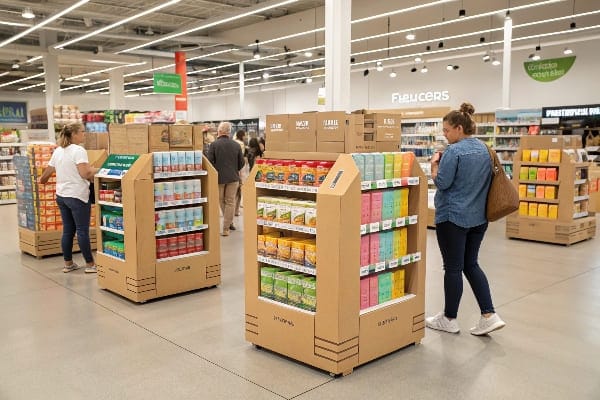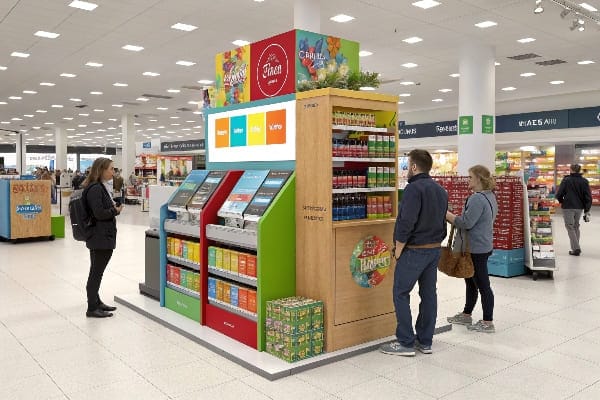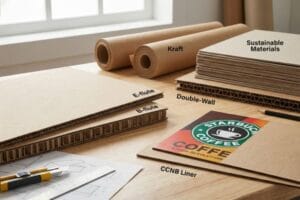Покупатели двигаются быстро. Мои товары привлекают внимание за считанные секунды. Мне нужна витрина, которая быстро устанавливается, выглядит эффектно и продаётся сразу. Дисплеи PDQ решают эту проблему уже сегодня.
Дисплей PDQ представляет собой предварительно упакованный, быстро устанавливаемый картонный блок, который поставляется готовым к розничной продаже, размещается на поддоне или полке и сразу начинает продаваться; он повышает видимость, контролирует выкладку и упрощает пополнение запасов.

Я постараюсь сделать это простым и полезным. Я объясню, что означает PDQ в магазинах и дизайне. Я сравню PDQ и POP. Я покажу, что PDQ означает для бизнес-результатов.
Что означает PDQ в мерчендайзинге?
Персоналу нужны чёткие инструкции. У них нет времени на создание сложных выкладок. Я использую PDQ, чтобы избежать путаницы, ускорить настройку и поддерживать чистоту на полках.
В мерчандайзинге PDQ расшифровывается как «Довольно быстро» или «Продукт быстро выставляется напоказ»; это предварительно упакованная, готовая к розничной продаже единица товара, которая быстро устанавливается, обеспечивает выкладку товара и стимулирует импульсивные покупки на кассе или в местах массового посещения.

Как команды используют PDQ 1
Устройство PDQ прибывает упакованным с продукцией. Сотрудник снимает крышку или отрывную ленту. Устройство помещается на полку, прилавок или поддон. Это занимает несколько минут. Я вижу меньше ошибок и более быструю перезагрузку2 . Я также вижу более чистые фасады в течение дня. Форма направляет продукт. Графика направляет покупателя. Сотрудникам магазина это нравится, потому что экономит рабочую силу в часы пик3 .
Где находится PDQ
Я размещаю PDQ рядом с кассой, на торцевых крышках 4 или на поддонах. 5 на прилавке лучше всего подходит для небольших товаров. 6 на поддоне — для сезонных наборов. 7 на полу — для больших упаковок. Я выбираю место по трафику, а не по привычке. Сначала я тестирую один магазин, а затем масштабирую.
Метрики, которые имеют значение
Я отслеживаю время настройки (8 минут) , сквозную продажу (9 минут ) и отсутствие товара на складе. Я также отслеживаю повреждения и возвраты. PDQ помогает по всем пяти направлениям. Прирост кажется небольшим по каждому магазину, но он суммируется по всей сети. Когда покупатель просит о чистом плане, PDQ завоёвывает доверие своей простотой.
| Аспект | Почему это важно | Моя заметка |
|---|---|---|
| Расфасованный10 | Сокращение трудозатрат и ошибок | Экономит минуты на магазин |
| Контроль облицовки11 | Имеет планограмму | Уменьшает беспорядок на полках |
| Компактный размер | Подходит для ограниченного пространства | Отлично подходит для оформления заказа |
| Графическая панель | Сигналы бренда быстрые | Помогает совершать импульсивные покупки |
| Крышка с отрывной полоской | Ускоряет открытие | Меньше использования ножей и отходов |
Что означает PDQ в дизайне?
У проектных групп сжатые сроки. Печать, резка и отправка должны осуществляться синхронно. Я использую правила проектирования PDQ, чтобы избежать непредвиденных обстоятельств и не использовать инструменты для сборки.
В плане дизайна PDQ придерживается обещания «быстроты»: линии штамповки, сортировка картона и печать — все это без инструментов, сборка занимает всего несколько минут; плоская упаковка поставляется в небольшом размере, легко разбирается и фиксируется простыми замками.

Дилайны, которые работают
Я начинаю с цельных или двухсекционных штампов. Предпочитаю автозамки на 12 дюймов и защипы. Избегаю маленьких, которые могут порваться, выступов. Чётко обозначаю порядок сгиба. Линии напряжения я размещаю вдали от глаз. Проектирую для плоской упаковки, чтобы сократить расходы на перевозку.
Материалы и печать
В большинстве устройств PDQ используется гофрокартон. Однослойный гофрокартон E, B или BE обеспечивает баланс качества и прочности печати. Я использую чернила на водной основе 13 для чистоты цвета. Цифровая печать позволяет выпускать небольшие тиражи и быстро вносить изменения. Это позволяет поддерживать сезонные выпуски и региональные испытания. Покупатели из Европы требуют больше экологических заявлений. Я заранее планирую использование материалов FSC и переработанного сырья.
Подгонка, формирование и испытание
Я тестирую настоящий продукт, а не заглушки. Проверяю отрывные полоски и перфорацию. Провожу транспортные испытания (14) и испытания на нагрузку. Слежу за риском воздействия влажности (15) . Использую простые клеи или скотч. Сборку сокращу до трёх этапов. Если продавцу нужно руководство, я переделываю дизайн.
| Элемент дизайна | Хороший выбор | Риск, если ошибаешься | Мой совет |
|---|---|---|---|
| Оценка доски | Одностенная канавка B/E | Раздавливание или деформация | Соответствие весу и климату |
| Закрытие | Автоматическая блокировка базы16 | Слабое дно | Добавьте двойную вытачку для тяжелых товаров |
| Графика | Крупные брендовые блоки | Мелкий текст | Используйте высокую контрастность рядом с логотипом |
| Метод печати | Цифровые технологии для коротких тиражей | Длинные переналадки | Используйте литолам для больших объемов |
| Устойчивость | Переработанный контент, FSC17 | Смешанные слои | По возможности избегайте пластиковых пленок. |
В чем разница между PDQ и POP?
Покупатели слышат оба термина. Некоторые считают, что это одно и то же. Сначала я объясняю область применения, а затем показываю, какое место PDQ занимает в POP.
PDQ — это подтип дисплеев POP (Point-of-Purchase); PDQ делает акцент на скорости и предварительной упаковке, в то время как POP охватывает все виды дисплеев для розничной торговли, включая напольные, паллетные, прилавочные, торцевые и интерактивные устройства.

Категория против инструмента
POP 18 — это обширная категория. Она включает в себя напольные дисплеи 19 , паллетные дисплеи 20 , полочные лотки 21 и многое другое. PDQ 22 — инструмент внутри этой категории. PDQ — это скорость подготовки и упаковка, готовая к розничной продаже. Многие POP-товары не имеют предварительной упаковки. Для них требуется планограммирование и ручная расфасовка. Я выбираю PDQ, когда времени и труда мало.
Варианты использования и влияние
Напольные POP-дисплеи могут выдерживать большую нагрузку и создавать сильное присутствие. По моему опыту, напольные дисплеи 2 часто занимают наибольшую долю в общем количестве товаров в кампаниях, поскольку они самостоятельны и рекламируют бренд. PDQ лучше всего работает, когда мне нужны быстрые пробные версии и строгий контроль непосредственно перед кассой. Когда я поддерживал запуск охотничьего бизнеса в США, команде требовались строгие сроки. Мы использовали лотки PDQ для крупных сетей и однопаллетные дисплеи для клубных магазинов. Такое сочетание позволило добиться как скорости, так и масштаба.
| Элемент | PDQ | ПОП (широкий) |
|---|---|---|
| Объем | Расфасованная, готовая к розничной продаже23 | Все типы дисплеев |
| Настраивать | Минуты, без инструментов 24 | Зависит от конструкции |
| Лучшее место | Касса, полки, небольшие помещения | Торцевые заглушки, проходы, поддоны |
| Объем | Маленький до среднего | От маленького до очень большого |
| потребность в рабочей силе | Очень низкий | От низкого к высокому |
| Цель | Скорость, импульс, испытания | Присутствие, повествование, глубина ассортимента |
Что такое PDQ в бизнесе?
Выставка — это не только искусство. Она должна окупаться. Я использую PDQ для ускорения запуска, сокращения трудозатрат и стабилизации затрат.
В бизнесе PDQ — это рычаг продаж и операций: он ускоряет время выкладки товара на полки, сокращает трудозатраты в магазине, защищает лицевые поверхности, стимулирует пробные показы и позволяет прогнозировать затраты на сезонные и новые продуктовые кампании.

модель рентабельности инвестиций
Я стараюсь делать простые вычисления. Я измеряю экономию за счёт более быстрой настройки и меньшего количества повреждений 25. Я отслеживаю добавление единиц продукции за счёт импульсивных покупок. Я сравниваю методы печати и размеры партий. Я тестирую один регион, а затем масштабирую. Для многих товаров повседневного спроса экономия на подъёме и трудозатратах компенсирует затраты на проектирование и оснастку при первом запуске.
Операции и сроки
Розничные сроки короткие. Я строю PDQ на основе логистики плоских упаковок и быстрой комплектации. На моём заводе три линии, поэтому я распределяю работу между ними, чтобы уложиться в сроки. Я держу цифровую печать в запасе на случай срочной смены. Я заранее замораживаю макеты, чтобы избежать переделок. Я отправляю чёткие этапы сборки в транспортную компанию.
Рынки и рост
Я вижу высокий спрос в Северной Америке, поскольку розничная торговля уже развита. Я вижу более быстрый рост в Азиатско-Тихоокеанском регионе благодаря урбанизации и появлению новых магазинов. Европа больше всех продвигает . Покупатели ценят переработанные материалы, чернила на водной основе и простоту переработки. Эти тенденции формируют спецификации PDQ. Бренды выбирают экологичность, потому что покупатели заботятся о них, а торговые сети обеспечивают соблюдение стандартов.
Риск и контроль
Правила торговли могут влиять на издержки. Колебания цен на сырье могут влиять на цены на доски. Я защищаю котировки коротким сроком действия и чёткими спецификациями качества. У меня есть вторая фабрика по производству досок, готовая к отправке. Я проверяю сертификаты. Я тестирую транспорт для дальних маршрутов. Когда я работал с американским брендом, специализирующимся на охоте, у нас были жёсткие сроки запуска. Сначала мы зафиксировали сроки вырубки PDQ, а затем и дизайн. Мы попали в окно, потому что конструкция была стабильной с первого дня.
| КПИ | Цель | Почему это помогает | Как помогает PDQ |
|---|---|---|---|
| Время настройки27 | Менее 5 минут | Меньше затрат на рабочую силу | Предварительно упакованный, с отрывной крышкой |
| Уровень урона | Менее 1% | Защитите маржу | Прочная доска, тест на пригодность |
| Минуты, которых нет в наличии | Меньше с каждым днем | Сохраняйте продажи | Легко заправляемый лоток |
| Рост сквозных продаж28 | +5–20% по сравнению с полкой | Проба и импульс | Яркая графика возле кассы |
| Стоимость перевозки за единицу | Опускайте каждый забег | Контроль прибыли | Плоские, вложенные друг в друга детали |
Заключение
PDQ — это быстрая настройка и понятные результаты. Он быстро размещается на полке, демонстрирует бренд и способствует запуску. Он прост в разработке, удобен в доставке и готов к продаже.
Перейдите по этой ссылке, чтобы узнать, как дисплеи PDQ повышают эффективность и улучшают качество обслуживания клиентов в розничных точках. ↩
Этот ресурс предоставит ценную информацию о повышении эффективности работы и удовлетворенности клиентов в розничной торговле. ↩ ↩
Изучение этой ссылки позволит вам получить представление о стратегиях эффективности и экономии затрат в сфере розничной торговли. ↩
Перейдите по этой ссылке, чтобы узнать об эффективных стратегиях максимизации продаж с помощью торцевых заглушек в планировке вашего магазина. ↩
Понимание Countertop PDQ может улучшить вашу стратегию розничной торговли за счет оптимизации размещения небольших товаров. ↩
Изучение Pallet PDQ может дать представление об эффективном сезонном маркетинге и более крупных экспозициях продукции. ↩
Перейдите по этой ссылке, чтобы узнать, как Floor PDQ может оптимизировать размещение продукции и эффективно повысить продажи. ↩
Сокращение времени настройки может значительно повысить эффективность и прибыльность вашего розничного бизнеса. ↩
Понимание сквозных продаж может улучшить вашу стратегию продаж и улучшить управление запасами. ↩
Изучив эту ссылку, вы узнаете, как предварительно упакованные продукты могут повысить эффективность и сократить количество ошибок в розничной торговле. ↩
Этот ресурс даст представление о том, как контроль выкладки товара может оптимизировать организацию полок и улучшить качество обслуживания клиентов. ↩
Перейдите по этой ссылке, чтобы узнать, как основания с автоматической блокировкой повышают эффективность и устойчивость упаковки. ↩
Откройте для себя преимущества чернил на водной основе для экологичной печати и ярких цветов. ↩
Перейдите по этой ссылке, чтобы узнать о передовых методах проведения испытаний на транспортировку, которые позволят гарантировать, что ваша продукция выдержит реальные условия. ↩
Ознакомьтесь со стратегиями оценки риска, связанного с влажностью, который имеет решающее значение для сохранения целостности продукта во время транспортировки. ↩
Перейдите по этой ссылке, чтобы узнать, как основание с автоматической блокировкой повышает прочность и эффективность упаковки. ↩
Узнайте об экологических преимуществах использования переработанных материалов и сертификации FSC в упаковке. ↩
Перейдите по этой ссылке, чтобы узнать о значении POP в розничной торговле, их типах и о том, как они повышают узнаваемость бренда. ↩
Узнайте о значении напольных дисплеев в маркетинге розничной торговли и о том, как они могут повысить узнаваемость бренда и объемы продаж. ↩
Перейдите по этой ссылке, чтобы узнать об эффективных стратегиях по увеличению эффективности использования паллет в вашей розничной торговле. ↩
Перейдите по этой ссылке, чтобы понять роль полок-лоток в улучшении видимости продукта и продаж в розничной торговле. ↩
Перейдите по этой ссылке, чтобы узнать, как PDQ повышает скорость и эффективность настройки в розничной торговле, что крайне важно в условиях сжатых сроков. ↩
Узнайте, как готовые к розничной продаже дисплеи могут улучшить вашу стратегию продаж и повысить вовлеченность клиентов. ↩
Узнайте об эффективности и удобстве установки витрин в розничных магазинах без использования инструментов, что позволяет сэкономить время и трудозатраты. ↩
Понимание этих преимуществ может помочь оптимизировать вашу розничную стратегию и повысить общую эффективность. ↩
Изучение этой темы позволит выявить ключевые тенденции, которые могут усилить экологические инициативы вашего бренда и повысить его рыночную привлекательность. ↩
Перейдите по этой ссылке, чтобы узнать об инновационных методах, которые могут упростить процесс настройки и сократить расходы. ↩
Этот ресурс содержит информацию о том, как увеличить продажи с помощью эффективных стратегий мерчандайзинга и маркетинга. ↩





